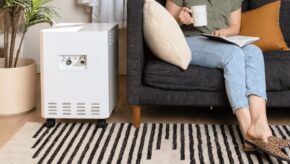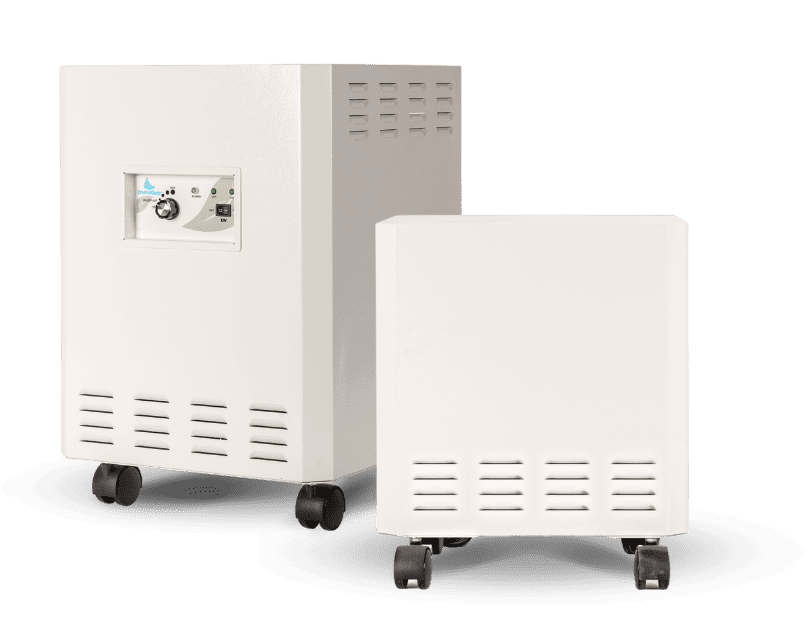Essential oils have recently become a new craze throughout households, with these fragrant oils and oil diffusers being integrated in these indoor environments. These extracted essential oils from fragrant plants are utilized for a variety of reasons, including for remedies to illnesses or other health issues (like headaches, colds, etc.), for aromatherapy purposes, and even for the singular purpose of spreading an aromatic smell throughout the living space of your home. These plant extract oils have many different methods of use such as oil-infused lotions that can be applied onto the skin – which allow for the oils to be absorbed into the bloodstream, or they can be diffused into the air where they can be inhaled into the body to bind to smell receptors with the goal of stimulating the central nervous system.
The use of essential oil diffusers, however, has been called into question, as research has been conducted that shows potentially hazardous reactions that people can experience from the misuse of these essential oils and essential oil diffusers. Additionally, some of the information that has been advertised by the manufacturers of these products have also led to health issues in those who use essential oils and diffusers in their personal indoor environment.
In this article we are going to discuss the pros and cons of essential oils and essential oil diffusers and learn alternative methods that can be implemented in a home to improve both health and air quality within this indoor environment.
How Do Essential Oil Diffusers Work?
For those who do not own an essential oil diffuser, the exact process that these devices perform in your home can be unclear. Typically, when these essential oil diffusers are used in an indoor environment, they will work by dispersing essential oils that were extracted from flowers, leaves, and other parts of flowers and plants, and vaporize them into the air. These diffusers can be utilized in a home to act as aromatherapy to improve the mind, body, and spirit.
Essential oil diffusers come in a variety of different types and models that are broken down into four main categories; ultrasonic, nebulizing, evaporative, and heat.
- Ultrasonic Diffusers: This type of essential oil diffuser is similar to that of a humidifier, as both require water to operate – with some ultrasonic diffusers doubling as a humidifier in your personal indoor environment. Together with water and essential oils, an ultrasonic diffuser will disperse this combination into the air.
- Nebulizing Diffusers: Unlike ultrasonic diffusers, nebulizing diffusers do not require water for its operation, rather it uses an atomizer to create fine particles out of the essential oil – which is than diffused into the air by this diffuser. The essential oil that is released from this diffuser is usually potent because the oils are not watered down.
- Heat Diffusers: Just as the name suggests, heat diffusers use warmth to evaporate the essential oils into the air. Most heat diffusers don’t use electricity, they use a candle that heats a reservoir of oil. This type of diffusers lacks the ability to control the diffusion of the oil.
- Evaporative Fan Diffuser: An essential oil diffuser that works through the evaporation of the oil into the air. This diffuser uses an absorbent pad within the diffuser, and with a few drops of essential oil placed on this pad it will then be left to evaporate.
What Essential Oils are Good For
The use of essential oils in a home can range depending on the objective you wish to accomplish in this indoor airspace. Most people utilize essential oils and oil diffusers to help improve health such as colds, headaches, and even through the use of aromatherapy, which is utilized for a variety of health conditions such as cancer. According to the National Cancer Institute, they state the following about this practice that uses essential oils;
“Aromatherapy is used by patients with cancer to help improve their quality of life and reduce stress, anxiety, pain, nausea, and vomiting caused by cancer and its treatment. This practice can be given or taken through different methods including indirect inhalation (oil diffusers), direct inhalation (individual inhalers), or massages (applied directly onto the skin).”
The different oils and extractions that are popularly used in essential oil diffusers offer different aromatherapy effects when deployed into the indoor environment. According to Medical News Today, these popular essential oils include the following uses and effects;
- Basil: An essential oil that is used to alleviate symptoms of depression; additionally, relieves headaches and migraines.
- Chamomile: Essential oil that has been said to treat eczema.
- Clove: A known topical painkiller that is commonly used for toothaches. This essential oil will help prevent vomiting and nausea, along with preventing gas in the gut.
- Eucalyptus: Eucalyptus will help relieve the airways during a cold or flu, this essential oil is often combined with peppermint. However, many people will find that they are allergic to eucalyptus essential oils.
- Jasmine: A popular essential oil, jasmine has been described as an aphrodisiac. Also, jasmine helps increase beta waves, which is linked to alertness.
- Lemon: An oil that is said to improve mood and help relieve symptoms of stress and depression.
- Tea Tree: An essential oil that is commonly used in shampoos and skin care products, and is said to have antimicrobial, antiseptic, and disinfectant qualities.
- Thyme: An oil that is said to help reduce fatigue, nervousness, and stress.
Can You Put Essential Oils in a Humidifier?
Air humidifiers are devices that are implemented into indoor environments to help restore humidity into the air, as a lack of humidity can lead to many health effects such as irritation to the eyes, skin, and other areas of the body. Most humidifiers that are used are constructed of plastic materials, which is a material that is not able to withstand certain added ingredients into this device. One thing that many people try to add to humidifiers are essential oils, however, is the addition of essential oils in your humidifier safe and effective?
Due to the fact that most humidifiers are constructed of plastic, this type of material will not be able to deal with the addition of essential oils into the device. The essential oils contain elements within them that will overtime break down the plastic and cause issues with the performance of your humidifier.
Are Essential Oils Safe to Inhale?
When it comes to the introduction of a new substance into your environment, such as essential oils, there is always a possibility that this substance can interact adversely with your help, especially when it is used improperly on an individual or in their indoor environment. Typically, most essential oils are fairly safe and free of side effects that can plague your health, unless you use these oils in a manner that was not deemed safe by the direction/use label on the product. According to the University of Minnesota study on Are Essential Oils Safe, they concluded the following;
“The dosage that you use of essential oils plays an important factor in essential oil safety. When some essential oils are used in the wrong doses or in too high a dose it was found (in animal and laboratory studies) to contribute to tumor development and other harmful changes to the body. Some essential oils can even be damaging to the skin, liver, and other organs if used improperly.”
The overall safety concerns associated with improper use of essential oils are present, but generally essential oils are safe when used externally in low concentration, avoiding exposure through ingestion. For essential oil inhalation, it is important to use intermittent exposure (suggested not more than 15 minutes in an hour).
Can You Be Allergic to Essential Oils
Can you be allergic to essential oils? An allergy to this type of liquid substance can vary depending on the individual, on the concentration of the essential oil they are exposed to, and the method in which they are exposed to the essential oils (inhalation or skin contact). Essential oils are considered to be a volatile liquid substance that is extracted from aromatic plant materials either through steam distillation or mechanical expression. There are, however, some essential oils that are manufactured with the assistants of chemical solvents, which are not considered to be true essential oils. These chemical solvent residues can alter the overall quality of the essential oil and can potentially lead to contamination of the fragrance and/or skin irritation.
According to the publication Aromatherapy with Essential Oils (PDQ®), they found that allergic reactions are sometimes reported from the use of essential oils, particularly in those who are given these oils as a topical on their skin. Typically, contact dermatitis has been found to be reported significantly with long-term exposure to essential oils from skin contact.
Essential Oils and Asthma
The herbal remedies that essential oils are said to contain can seem sometimes too good to be true, and when it comes to common conditions that many American suffer from like asthma, will this form of therapy help? The Asthma and Allergy Foundation of America weighed in on this topic, as they explained if essential oils can help asthma, “There is no evidence that illustrates that essential oils can help asthma, in fact, the particles released from the oils when breathed in can actually potentially trigger an asthma attack in some cases”.
Some essential oil can contain and emit volatile organic compounds (VOCs) into the air that can affect indoor air quality – similar to the use of incense, air fresheners, and even scented candles in an indoor environment. When air quality is compromised by these organic compounds in the air it can contribute to the adverse effects of asthma, allergies, and other illnesses, according to the AAFA.
The Effects of Evaporating Essential Oils on Indoor Air Quality
Indoor air quality is an important topic that is not often fully addressed by many Americans, as the hazardous impact of poor indoor air quality on human health is not completely understood by most individuals. There are many everyday items in your home that are used that can be major contributors to elevated pollution levels within this indoor environment, such as cleaning products, new carpeting, cooking emissions, candles, and even sometimes essential oils that are diffused into the air as a vapor.
A study called The Effects of Evaporating Essential Oils on Indoor Air Quality, was conducted to demonstrate the impact that essential oils contribute to indoor air quality levels when used in an enclosed, indoor space. This study states the following about indoor air quality after essential oil use, “Indoor CO, COs, and TVOCs levels have increased drastically after burning essential oils, while PM10 concentrations show an opposite trend”.
Selecting the Best Air Purifier for Asthma & Other Environmental Triggers
When it comes to improving indoor air quality, the best means to accomplish this restoration of your indoor air quality levels is through the use of an effective air purifier that is able to combat a multitude of airborne pollutants in the home. Similar to the potential emissions released from essential oils such as VOCs, chemical odors, and even particulate matter, there are other sources present in a home that can also contribute to higher levels of these pollutants traveling in your home’s air.
The process of selecting the best air purifier for your home, whether it is to combat asthma and allergies or remove environmental triggers from the air of your environment, it is important to understand the technology that is used within the purification system. The EnviroKlenz Air Purifier, unlike other air purifiers that use the same three traditional air purifier technologies (ozone, carbon, and ionization), uses a patented earth mineral technology that is able to contain and neutralize and/or breakdown a wide variety of airborne pollutants including noxious and toxic chemicals and odors from the airspace. This proprietary technology is implemented into the first stage filtration within the EnviroKlenz Air Purifier to combat VOCs, noxious odors, and a broad spectrum of chemical compounds from the air, removing them through adsorptive neutralization, rather than just retaining them within the media of a filter, like other technologies. The second stage filtration is a Hospital-Grade HEPA filter that is able to capture and remove particulate matter larger than 0.3 microns in size, this includes fine particulate matter that can enter into your air and potentially exacerbate allergy and asthma symptoms.

In this chamber study, a volatile organic compound was released in an environmental chamber under ambient conditions. The IQAir® was the air system that was able to remove the chemical the quickest, but since the system uses carbon media, the chemical has the potential to be released back into the atmosphere with an increase in temperature or changes to humidity and pressure. In some of our real-world evaluations, we have seen carbon systems start to desorb VOCs as the temperature rises towards only 80 degrees. The EnviroKlenz® Air System out-performed the BlueAir® and Molekule® systems, while also offering more than just physical absorption. The EnviroKlenz® Air Cartridge works through a combination of physical and chemical mechanisms.
Article Sources:
- VeryWellHealth.com: The Different Types of Essential Oil Diffusers (link)
- National Cancer Institute (NIH): Aromatherapy With Essential Oils (PDQ®)- Patient Version (link)
- Medical News Today: Aromatherapy: What You Need to Know (link)
- University of Minnesota: Are Essential Oils Safe? (link)
- PDQ Integrative, Alternative, and Complementary Therapies Editorial Board: Aromatherapy with Essential Oils (PDQ®) (link)
- Asthma and Allergy Foundation of America (AAFA): AAFA Explains: Can Essential Oils Help Asthma? (link)
- Department of Environmental and Occupational Health: The Effects of Evaporating Essential Oils on Indoor Air Quality (link)









